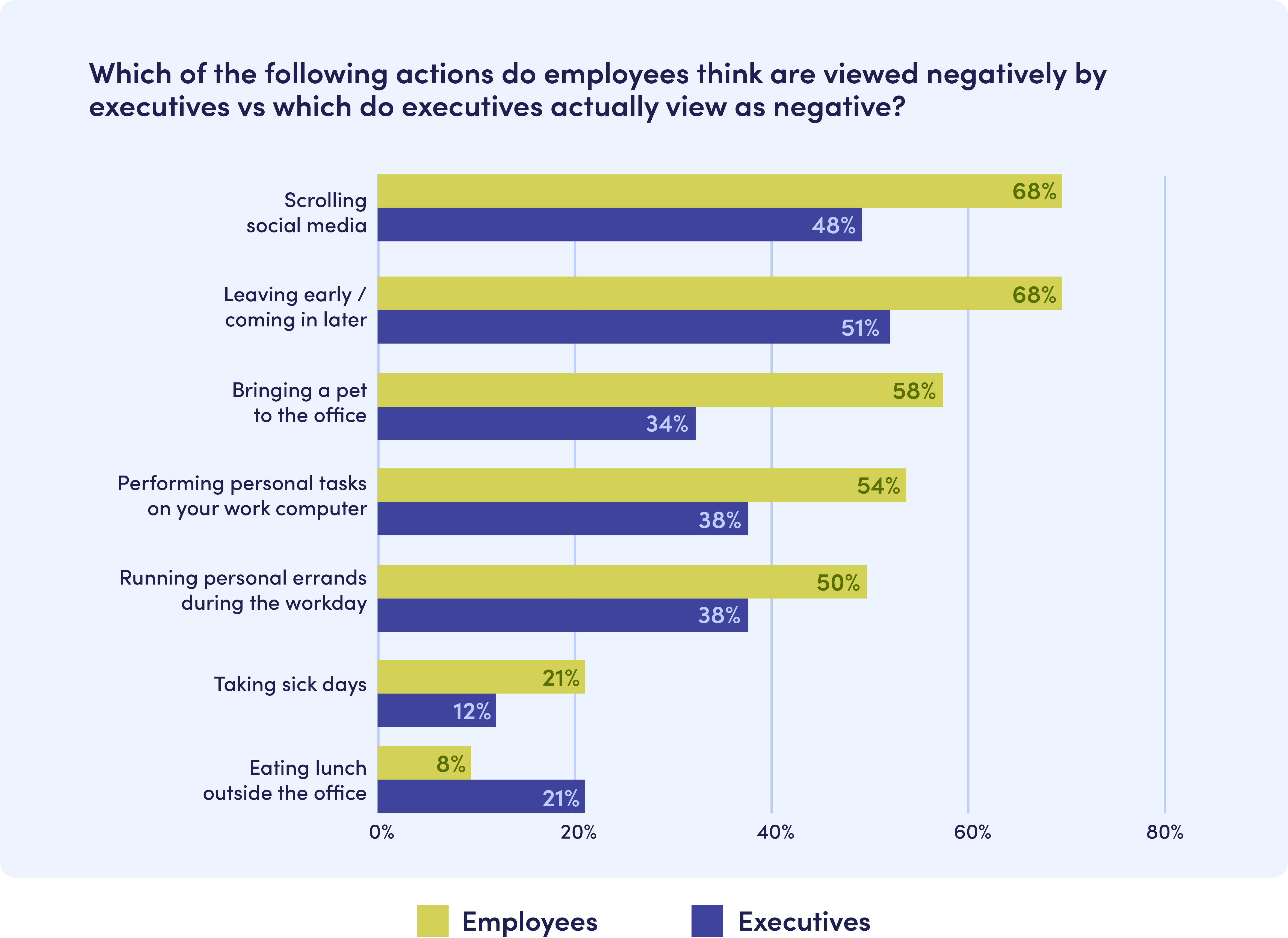The workplace has had a full makeover. People are no longer bound to working between 9 and 5. They’re working from home some days and from their bedrooms other days. Many of the traditional office norms of the pre-pandemic days have changed, but it’s not always clear to employees what the new norms are. In fact, many employees are unsure about the new rules of the workplace.Executives are also entering this new reality of work. They’ve had to adapt to a more flexible workplace and are much more understanding of employees’ needs. So if executives are willing to create a much more flexible workplace, why are employees still nervous? In our latest workplace trends report, At Work: how employees and executives really feel about the workplace, we uncover the gaps that divide leaders and their teams. We were curious to know which traditional office taboos give employees a reason to stress, for example, scrolling on social media or bringing their dog into work. We also wanted to know if executives still viewed those behaviors as negative.
So we surveyed 1,000 employees and 250 executives in the United States to find out how big of a deal office stigmas really were. Here’s what we uncovered.
Despite increased flexibility in the workplace, employees still feel there is a stigma around leaving the office early.
With new ways of working and new places to work (hello living room!), we’d expect employees to feel that they have much more flexibility in the hours they come in and out of the office. However, according to our survey, two-thirds (68%) of employees say there is a stigma around leaving early or coming in later. When we asked executives about how they feel about folks coming in later or signing off when their work is done, only 51% said they would view this as negative. In our report, we discovered lack of flexibility to be a top 4 deal breaker for US employees coming into the office. So it’s possible that executives have caught wind of how important flexible hours are. They might be lowering any pre-existing, negative perception of folks walking out the office door earlier than 5 pm. The biggest disconnects between employees and executives were around bringing a pet into work and scrolling through social media. We also found that, among executives, those aged 40 or older were more likely to view scrolling through social media and bringing a pet in as negative. Check out the chart below to see where else employees and executives differ in their views:

Female executives view office taboos as more negative than male executives
According to our data, female executives found almost every office taboo to be negative more than their male counterparts did. We saw the biggest gaps between male and female executives when it came to taking time out of the day to run a personal errand or do personal tasks on a work computer. The only areas where male executives viewed something as more negatively than women was taking sick days and having lunch outside the office. Only 3%* of female executives viewed taking a sick day as negative compared to 16% of male executives.

*Small base sizes indicate that a percentage was derived from a sample size of less than 100 respondents. As such, this percentage is subject to increased variance. Due to the small sample size of respondents, the data is not statistically significant enough for us to draw a firm conclusion. However, we have enough data to know that our hypothesis is moving in the right direction.
If the workplace is about productivity, then time at the office is important.
In our survey, we asked respondents what the primary goal of the workplace is: productivity or relationship-building. We found that executives who voted for productivity over relationship-building were also more likely to find leaving the office early as a negative behavior. Unsurprisingly, they might believe productivity levels go down once employees leave the office for the day. The same is true for employees. Employees who voted for productivity over relationship-building were more likely to worry about the stigma of leaving early or coming in later.

The takeaway
Navigating the post-pandemic office has presented challenges for both executives and employees. Employees are still figuring out what the new office do’s and don'ts are when it comes to personal time, flexible hours, and comfort in the office. On the other hand, executives' views have changed. They’ve adjusted pre-pandemic views on office stigmas and are accepting new norms that empower employees.
So what are workplace leaders to do? It’s important that employees understand how flexible the new workplace is. Communicate out your company’s policies around work hours, time off, pets in the office, and more so there is no misunderstanding. You should also arm your employees with the tools that allow them to make these flexible choices at work. A scheduling tool and a desk booking tool are great starting points. By empowering employees to own their schedules and encouraging executives to continue communicating their policies, you can help close the gap on office taboos.
Read more
Searching for a visitor management solution? Learn what to look out for and how to choose the best tech for your team.
Managing your space well doesn’t have to be difficult. But if you want to be successful, you need the right approach.
A well-run workplace can set your team up for success. Learn why workplace management matters and how to do it right.
Workplace security is critical to the future of your business. Learn why it matters, what threats to watch for, and how to strengthen your workplace security plan.
In this post, we’ll explore what workplace compliance is and how to build a compliance culture for your organization.
With more folks sending personal packages to the workplace, having a sound mailroom management system in place is key.









